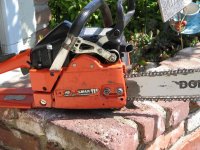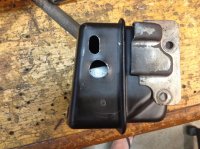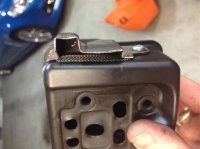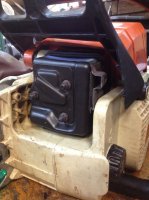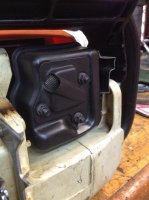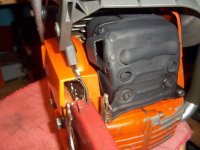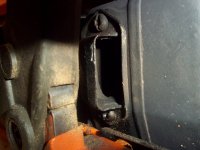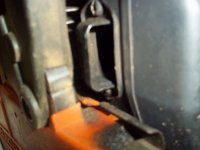You are using an out of date browser. It may not display this or other websites correctly.
You should upgrade or use an alternative browser.
You should upgrade or use an alternative browser.
Muffler mod pictures
- Thread starter czar800
- Start date
Mag Craft
Super OPE Member
- Local time
- 10:21 PM
- User ID
- 633
- Joined
- Jan 20, 2016
- Messages
- 271
- Reaction score
- 752
- Location
- Carpenter, Wyo.
Mag Craft
Super OPE Member
- Local time
- 10:21 PM
- User ID
- 633
- Joined
- Jan 20, 2016
- Messages
- 271
- Reaction score
- 752
- Location
- Carpenter, Wyo.
- Local time
- 12:21 AM
- User ID
- 21
- Joined
- Dec 4, 2015
- Messages
- 5,336
- Reaction score
- 28,488
- Location
- In a meeting
Thought you did the old spot-stitch with mig, came out nice !!!That's tig with 3/32" filler. I had to just drag it in a straight line to keep the puddle connected. These thinner muffler deflectors are harder to weld. I liked the 16 gauge ones.
Especially trying to get through the screen gap, these thin ones just disappear before they puddle. Its like too much filler is the right amount
Brewz
Free Range Human in a Tax Farm
- Local time
- 4:21 PM
- User ID
- 550
- Joined
- Jan 16, 2016
- Messages
- 4,217
- Reaction score
- 14,325
- Location
- Hunter Valley - Australia
- Local time
- 12:21 AM
- User ID
- 319
- Joined
- Dec 29, 2015
- Messages
- 9,614
- Reaction score
- 63,350
- Location
- Strong Island NY
I'm finding these super difficult to get a nice bead on. My welds come out quite poorly on them.Thought you did the old spot-stitch with mig, came out nice !!!
Especially trying to get through the screen gap, these thin ones just disappear before they puddle. Its like too much filler is the right amount
I'm not sure if it is embedded impurities in the base metal or not. I can get them to seal, but they just don't come out like my other beads.
Brewz
Free Range Human in a Tax Farm
- Local time
- 4:21 PM
- User ID
- 550
- Joined
- Jan 16, 2016
- Messages
- 4,217
- Reaction score
- 14,325
- Location
- Hunter Valley - Australia
I believe grinders were invented by Electricians like myself so they could fix their welding
- Local time
- 12:21 AM
- User ID
- 319
- Joined
- Dec 29, 2015
- Messages
- 9,614
- Reaction score
- 63,350
- Location
- Strong Island NY
"Grinders and paint make bad welders what they ain't"
- Local time
- 12:21 AM
- User ID
- 21
- Joined
- Dec 4, 2015
- Messages
- 5,336
- Reaction score
- 28,488
- Location
- In a meeting
I see lots of "exploding" happening with them, even after cleaning the metal with a whiz-wheelI'm finding these super difficult to get a nice bead on. My welds come out quite poorly on them.
I'm not sure if it is embedded impurities in the base metal or not. I can get them to seal, but they just don't come out like my other beads.
I think you nailed it, with impurities. Rust and oil dont mix well when welding
I had some blow through on my last one, I think Red is making the deflectors thinner, and will run a pulse on my next one, hopefully this weekend.
I seen your mod to Mustang Mikes 044/046 cover, that looked very nice.
- Local time
- 12:21 AM
- User ID
- 319
- Joined
- Dec 29, 2015
- Messages
- 9,614
- Reaction score
- 63,350
- Location
- Strong Island NY
Thanks Mopar.
Mikes mufflers were virgin material. Exactly.
I plan on trying Jody Collier's rule of 33 pulse on my next muffler project. I use an inverter, so I can pulse up to 999 times a second.
Mikes mufflers were virgin material. Exactly.
I plan on trying Jody Collier's rule of 33 pulse on my next muffler project. I use an inverter, so I can pulse up to 999 times a second.
Brewz
Free Range Human in a Tax Farm
- Local time
- 4:21 PM
- User ID
- 550
- Joined
- Jan 16, 2016
- Messages
- 4,217
- Reaction score
- 14,325
- Location
- Hunter Valley - Australia
Thats why I took the time to learn to weld properly.
For a leco, I can stick mig tig and oxy weld, brais, silver solder, use plasma, oxy cut etc.
Handy skils
Exploding welds will be impurities in the metal for sure
For a leco, I can stick mig tig and oxy weld, brais, silver solder, use plasma, oxy cut etc.
Handy skils
Exploding welds will be impurities in the metal for sure
- Local time
- 12:21 AM
- User ID
- 21
- Joined
- Dec 4, 2015
- Messages
- 5,336
- Reaction score
- 28,488
- Location
- In a meeting
I am stuck in the darker ages, just before inverters were gaining popularity, I grabbed my 350LX.Thanks Mopar.
Mikes mufflers were virgin material. Exactly.
I plan on trying Jody Collier's rule of 33 pulse on my next muffler project. I use an inverter, so I can pulse up to 999 times a second.
I can only go 10 pulses per second, but I was thinking of trying 1.5 seconds of full petal, then 1/2 second at 60% to start with.
mdavlee
Hillbilly grinder
- Local time
- 12:21 AM
- User ID
- 279
- Joined
- Dec 28, 2015
- Messages
- 14,194
- Reaction score
- 64,630
- Location
- TN
I put a screwdriver under it and tapped the edge down with a hammer. Welded it up and then put a screen and took a round punch and tapped the edge at the front down to crimp the screen in place.Thought you did the old spot-stitch with mig, came out nice !!!
Especially trying to get through the screen gap, these thin ones just disappear before they puddle. Its like too much filler is the right amount
- Local time
- 12:21 AM
- User ID
- 319
- Joined
- Dec 29, 2015
- Messages
- 9,614
- Reaction score
- 63,350
- Location
- Strong Island NY
You already know that Tig is 90% Indian and 10% arrow.
I bet you'll be just fine.
After I learned a bit, I settled down to using traditional tranny machine settings for everything. When you don't know what you're doing, you think it's the better machine that makes the better welds.
Hood time makes the better welds, an you have that already.
I bet you'll be just fine.
After I learned a bit, I settled down to using traditional tranny machine settings for everything. When you don't know what you're doing, you think it's the better machine that makes the better welds.
Hood time makes the better welds, an you have that already.
- Local time
- 12:21 AM
- User ID
- 319
- Joined
- Dec 29, 2015
- Messages
- 9,614
- Reaction score
- 63,350
- Location
- Strong Island NY
I use 60Hz, 65% EN and no pulse for aluminum. Sound familiar?
Everyone recommends 100Hz. I learned on a Syncrowave 250. I still like the settings.
Everyone recommends 100Hz. I learned on a Syncrowave 250. I still like the settings.
- Local time
- 12:21 AM
- User ID
- 21
- Joined
- Dec 4, 2015
- Messages
- 5,336
- Reaction score
- 28,488
- Location
- In a meeting
60hz for the hf start ?I use 60Hz, 65% EN and no pulse for aluminum. Sound familiar?
Everyone recommends 100Hz. I learned on a Syncrowave 250. I still like the settings.
Thats the only frequency I can controll on mine other than the pulser
68% EN is max penetration on mine and thats at setting 10
Setting 3 is 50/50
I usually roll the knob close to #5 for aluminum............... about 55% EN
I've seen the same model welder have different settings in 2 different places
czar800
Mastermind Approved!
- Local time
- 12:21 AM
- User ID
- 533
- Joined
- Jan 14, 2016
- Messages
- 7,167
- Reaction score
- 37,480
- Location
- Ellwood City
Hands down the double barrel guys win!
Mag Craft
Super OPE Member
- Local time
- 10:21 PM
- User ID
- 633
- Joined
- Jan 20, 2016
- Messages
- 271
- Reaction score
- 752
- Location
- Carpenter, Wyo.
I use 60Hz, 65% EN and no pulse for aluminum. Sound familiar?
Everyone recommends 100Hz. I learned on a Syncrowave 250. I still like the settings.
A Syncrowave 250 is what I have and still use. It is a good machine.








